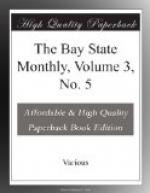Hazen began his survey March 21, 1741. The English instructions required a course due west, and Governor Belcher and his Council ordered ten degrees for the then variation of the needle, which was not quite enough, so that the line actually ran slightly north of due west, and saved to Massachusetts at the west end of the line (in Williamstown) about 1 deg. and 50 min. After the party left the Connecticut river on April 6, they slept on snow at a depth of two or three feet every night till they crossed the Hoosac river in Williamstown on April 12. “It clouded over before Night and rained sometime before day which caused us to stretch Our blankets and lye under them on ye bare Ground, which was the first bare ground we laid on after we left Northfield.” It was on April 9 that they measured the present north line of Heath. Let the clear-eyed surveyor describe in his own words the general situation of the future Fort Shirley.
“At the End of three miles we came to a large brook running Southeasterly and at the End of this days measure to another large brook running Southerly, by which we took Our lodging. Here we tract a Bear and therefore named it Bear brook, both these brooks being branches of Deerfield River. The land this day was some of the best of Land and for three miles together. The last year Pigeons’ nests were so thick that 500 might have been told on the beech trees at One time, and they could have been counted on the Hemlocks as well, I believe three thousand at one turn Round. The snow was for ye most part three feet deep, the weather was fair and wind Northwest.”
Although Hazen named the last mountain on his line where he supposed the eastern line of New York, would ultimately run “Mount Belcher,” in honor of the Governor who had commissioned him to lay it, the just unpopularity of the line itself and Belcher’s connection with it immediately caused his recall from his government, and the appointment of William Shirley in his stead. Belcher was Massachusetts born; while Shirley, though British born, became one of the ablest and most successful of all the colonial governors of Massachusetts. The building of Fort Shirley in 1744 and the naming it after the new Governor, as well as the building a little later of the two forts to the westward,—Fort Pelham in Rowe and Fort Massachusetts in what is now North Adams,—all within a couple of miles of the new boundary line, showed a concern of the colony for its now greatly curtailed northern limits, as well as a much greater concern for the defence of the scattered settlements west of the Connecticut river from the French and Indians, who had several well-trod war-paths to the English settlements on the Connecticut and the Deerfield.




